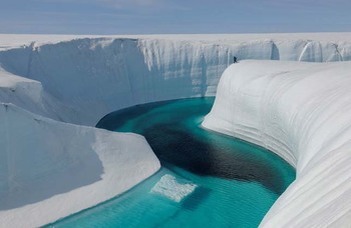Global sea-level rise caused by arctic winds
The Greenland ice sheet has been losing its mass at an ever-accelerating rate in recent decades, which has contributed to a rise in global sea levels. This process is expected to continue due to anthropogenic climate change. Taking a unique approach to modelling, an international research group led by Dániel Topál, who is an assistant research fellow at the Institute for Geological and Geochemical Research at the Research Centre for Astronomy and Earth Sciences, demonstrated that between 1990 and 2012
the observed change in atmospheric circulation caused over half of the sea-level rise associated with the loss of the ice sheet in Greenland.
However, global climate models – underestimating the currently observed increase in ice melt – suggest that the melt is predominantly due to a generally warmer atmosphere caused by anthropogenic greenhouse gases rather than regional wind changes. This bias can severely limit the potential of models to make accurate predictions concerning future sea-level changes.

The authors simultaneously analysed modern satellite-based observations and climate reanalyses, as well as historical climate data obtained from ice cores and tree rings. The results reveal that large-scale atmospheric circulation has consistently played a fundamental role in controlling warming in and around Greenland over the past 400 years.
According to the authors, the Arctic wind-driven circulation variability is connected to the decade-long tropical sea surface temperature anomalies in the Pacific Ocean.
At the same time, much uncertainty remains, particularly regarding tropical-Arctic linkages, and it is also unclear whether global climate models respond to the anomalous tropical sea surface temperatures in a similar way as observed. The authors emphasise that although the climate models associated with Coupled Model Inter-Comparison Project Phase 6 (CMIP6) project faster and more extensive Greenland melting rates than the earlier generations of models, without adequate simulations of atmospheric circulation, these projections should be treated with care.

The observed (a) and (b) the nudging experiment-derived changes in surface temperature (linear trend) in and around Greenland between 1990 and 2012 (when the strongest rate of warming was experienced over the last 40 years). Hatching indicates the statistically significant (p<0.05) trends. The model experiment reflects over 50% of the observed spatial trends on a regional average.
The findings presented in this new study highlight the urgent need for a better understanding of the observed climate changes in the Greenland ice sheet. This would enable more effective adaptation to address the challenges posed by global sea-level rise.
.jpg)
According to the first author of the study, Dániel Topál, Ph.D. candidate, “One of the main priorities of our future research is to focus on why models tend to overestimate the degree of warming caused by anthropogenic forcing in some parts of the Arctic without taking into account the atmospheric circulation anomalies observed since 2000. It is fundamental that we can determine accurately what physical processes are inducing the Arctic changes. Only then can we adequately prepare for the implications of the Greenland ice-sheet melt.”
Source: ELTE Faculty of Science

